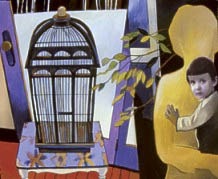
First Times
Written by Mattias Frey | Posted by: Anonymous
Nearly three years ago, Brian Kamerzel faced a terrifying, existential dilemma: "What to do?" Having recently completed his studies at the New York School of Visual Arts (SVA), the Southbury, Connecticut native was looking for the subject of his first film after college. His search ended at the local elementary school where his mother teaches. There he stumbled upon art teacher and accomplished painter Florin Ion Firimita.
Although Kamerzel had made primarily experimental films at SVA, the story behind Firimita’s life and art compelled him to embark on the almost three year film project. The documentary that emerged, "The Art of Leaving: A Portrait of Florin Ion Firimita," is based on the artist’s private journal entries over the past 20 years, exploring Firimita’s extraordinary past and how it resurfaces in his art.
Born and raised in Romania during the Cold War and orphaned at the age of 16, Firimita survived the terror and tedium of the police state through small acts of resistance: dropping cans of paint on parade banners and diluting glue so that party posters would quickly fall from walls. After participating in the December 1989 revolution, he fled to the U.S. to begin a new life.
Given such dramatic subject matter a lesser director might have offered a clichéd tale of political intrigue and artistic redemption. It is to Kamerzel’s credit then that his documentary proves far from conventional. "The Art of Leaving" is a richly textured film that operates on a range of levels.
The film begins with a washed-out black and white that resembles an x-ray and travels through Firimita’s life with still photographs, surveillance tape, archival footage, and color video, to name a few of the source materials. The narration wanders from Firimita’s subtitled Romanian, to the director reading Firimita’s journals in English, to screen captions without an aural referent. According to Kamerzel, this variety derived partly from his background in experimental film, but also represents a process of learning. "I didn’t want to get too rigid in this film, that I had to do things this way or that. I wanted to try out different cameras and film stocks and give myself experience."
With a swirl of media and flurries of special effects, the film recalls Firimita’s "Remembrance of Things Past" series, which combines childhood postcards and family photographs with painted elements. It is clear, however, that Kamerzel’s rendering is more than a literal translation. "The film takes Florin’s techniques as a point of departure and to that extent, yes, it’s expressionist — it tries to do what he does in paint in order to explain a feeling or moment or memory. But as the film took shape it also took on its own meaning. That’s what Florin wanted — he wanted the film to exist on its own and to be about him as little as possible."
The idea to make a documentary that refers to its subject "as little as possible" touches on the complexity of Kamerzel’s project and his collaboration with Firimita. The film meditates on how it is possible to represent a person and his art. For example, we don’t see Firimita’s face for the first 15 minutes of the film, and then only a quick glimpse — instead we get to know him through childhood pictures, his voice (in Romanian), and his artworks. "I researched a number of art documentaries and found that in most the structural line was determined by the subject. In this film I wanted to reject that because I feel it distances the viewer from the art and the process of art — the things I wanted to highlight in this film. I wanted to leave the question of interpretation to the viewer."
Indeed, the whole question of representation was one of the most difficult parts of the process for Kamerzel. "[Unlike with an experimental film] I was taking on a huge responsibility with the documentary. I wanted to be as truthful as possible to this person’s life, but I wanted to be less explanatory and let the images speak for themselves." This dilemma led to a number of creative solutions. For example, Kamerzel gave Firimita a camera so that he could film himself painting. In another instance, Kamerzel shot footage in Rome, a stopping point for Firimita before coming to America. His idea was not to recreate Firimita’s journey, however. Kamerzel, who was himself in Europe for the first time, wished instead to capture the city literally from the perspective of someone there for the first time.
One of the more striking scenes in the film is a sequence of informal interviews with Firimita’s pre-teen students. They present their artworks and the camera looks on while they see a reproduction of the "Mona Lisa" for the first time, blissfully unaware of history’s overdeterminations. When asked why he included the scene in the film, Kamerzel revealed, "Kids talk about their artwork and creativity in their own way. I wanted to contrast that with Florin, who has had a whole lifetime to think about his art in the context of his past."
This scene is exemplary in the sense that "The Art of Leaving," for as much as it deals with emigration, death, and melancholy, is just as concerned with "first times": initial experiences with new places, freedoms, lifestyles, artistic forms, and ways of seeing. In its essence the film is about the liberating aspects of working without fixed points of reference. For Kamerzel, himself a professional director for the first time, the metaphor is all the more fitting.
When asked if his next film would also be a documentary or if he would return to making experimental films, Kamerzel was typically cryptic. "I might do a film about my great aunt, a nurse in World War II who went on to become a missionary in Africa. But even though I made one, I’m not interested in making documentaries."
What to do?
The Art of Leaving is an official selection of this year’s Santa Fe International Film Festival (December 3 - 7). For more information about Florin Ion Firimita, visit www.absolutearts.com/portfolios/f/fifstudio/.











